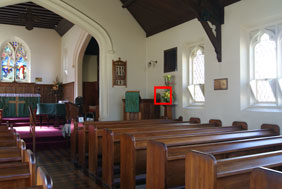Sony Alpha DSLR-A330
-
-
Written by Gordon Laing
Sony Alpha DSLR-A330 vs Canon 1000D / XS vs Nikon D90 High ISO Noise
|
 | To compare noise levels under real-life conditions we shot this scene with the Sony Alpha DSLR-A330, Canon EOS 1000D / Rebel XS and Nikon D90 within a few moments of each other using each of their ISO settings. Each camera was fitted with its respective kit lens (see details below) and adjusted to deliver the same vertical field of view. The images were taken in Aperture Priority at f8 with Auto White Balance |
High ISO Noise Reduction was set to the default On and Normal settings for the A380 and D90 respectively. The Sony’s D-Range Optimizer, Canon’s Auto Lighting Optimizer and Nikon’s Active D-Lighting were all disabled for this test as they can artificially increase noise levels. The crops are taken from the area marked with the red rectangle near the centre of the frame, and presented here at 100%.
We’ve compared the Alpha A330 against its one of its main 10 Megapixel rivals here, the Canon EOS 1000D / Rebel XS, along with the Nikon D90 to illustrate what you can expect from a higher-end camera. The D90’s crops show a slightly smaller area due to its slightly higher 12.3 Megapixel resolution.
The D90 may be comfortably more expensive than the A330, but shares the same sensor and imaging pipeline as the more affordable D5000, a model that’s a little closer to the A330’s price point. So while the kit lenses supplied with each of these Nikon bodies are different, much of the image quality and character you see from the D90 across these results pages is also representative of the D5000. This particularly applies to the crops taken from near the middle of the image, where both Nikkor kit lenses perform similarly, especially when closed to f8 as here.
Sony’s restrained image processing results in slightly soft looking crops here compared to those from the Nikon D90 and especially the Canon EOS 1000D / Rebel XS. As discussed on the first results page, this is mostly down to the default image processing settings which can of course be tweaked for a punchier result – although it’s slightly odd for Sony to err on the side of caution by default for a body aimed at DSLR-beginners, many of whom will be upgrading from a compact.
In terms of noise, all three cameras are almost 100% clean at 100 and 200 ISO, with subtle artefacts only beginning to make an appearance at 400 ISO. At this point you can begin to see the differences between each camera’s approach to noise and noise reduction. Nikon goes for a relatively hands-off approach with visible speckles subtly appearing from 400 ISO onwards, although impressively it manages to avoid undesirable chroma artefacts throughout its range. Canon applies greater noise reduction to avoid speckles but the sensor used in the 1000D / XS suffers from chroma artefacts at higher sensitivities. In the meantime, the Alpha A330 is closer to the Canon, with increasingly obvious chroma artefacts but blotchier noise reduction.
At 800 ISO, all three cameras are suffering more than before, but the A330 takes a noticeable dive in quality, becoming quite soft. At 1600 ISO, the situation becomes even worse with splotchy noise reduction eliminating fine detail – just compare it with what the Canon EOS 1000D / XS and Nikon D90 are outputting.
The Canon bows out at this point, and the A330 arguably should have followed-suit. Instead it offers a compromised 3200 ISO option which is really only suitable for emergency use. In the meantime, the D90 – and lest we forget, also the D5000 – keeps noise to a respectable minimum, delivering a result at 3200 ISO that’s better than the A330 at 800 ISO. Even the Nikon’s maximum 6400 ISO sample is usable at smaller sizes.
Given the same sensor as its predecessor, this is a predictable result for the A330. It may deliver slightly lower noise levels than its pricier sibling the A380, but remains behind the competition. Sure the Nikon D90, and even the cheaper D5000, are pricier than the A330, but the Canon 1000D / XS isn’t and simply performs better at higher sensitivities. If you shoot at 400 ISO or below, the A330 is fine, but at 800 ISO and above, there are better models available.
Now let’s see more real-life examples across its sensitivity range in our Sony Alpha DSLR A330 Gallery.
Sony Alpha DSLR-A330 with Sony DT 18-55mm SAM |
Canon EOS 1000D / Rebel XS with Canon EF-S 18-55mm IS |
Nikon D90 with Nikkor DX 18-105mm VR | ||
 |
 |
 | ||
100 ISO |
100 ISO |
L1.0 (100 ISO) | ||
 |
 |
 | ||
200 ISO |
200 ISO |
200 ISO | ||
 |
 |
 | ||
400 ISO |
400 ISO |
400 ISO | ||
 |
 |
 | ||
800 ISO |
800 ISO |
800 ISO | ||
 |
 |
 | ||
1600 ISO |
1600 ISO |
1600 ISO | ||
 |
 |
 | ||
3200 ISO |
3200 ISO not available |
3200 ISO | ||
 |
 |
 | ||
6400 ISO not available |
6400 ISO not available |
H1.0 (6400 ISO) |




